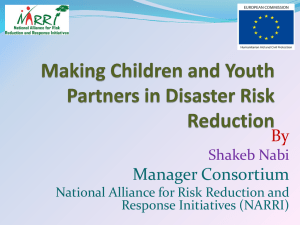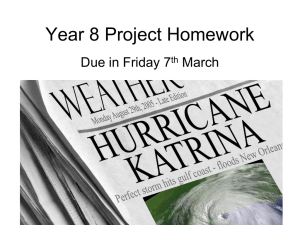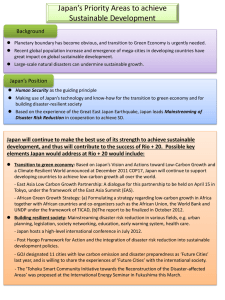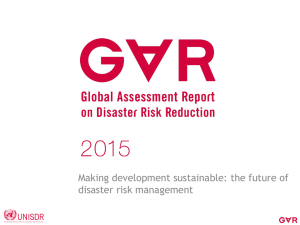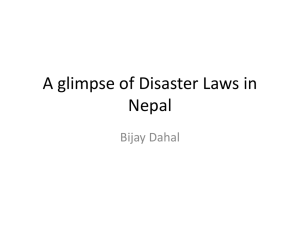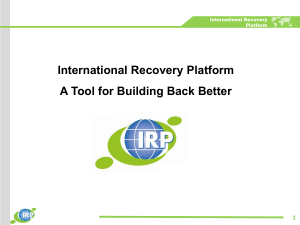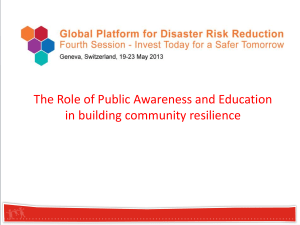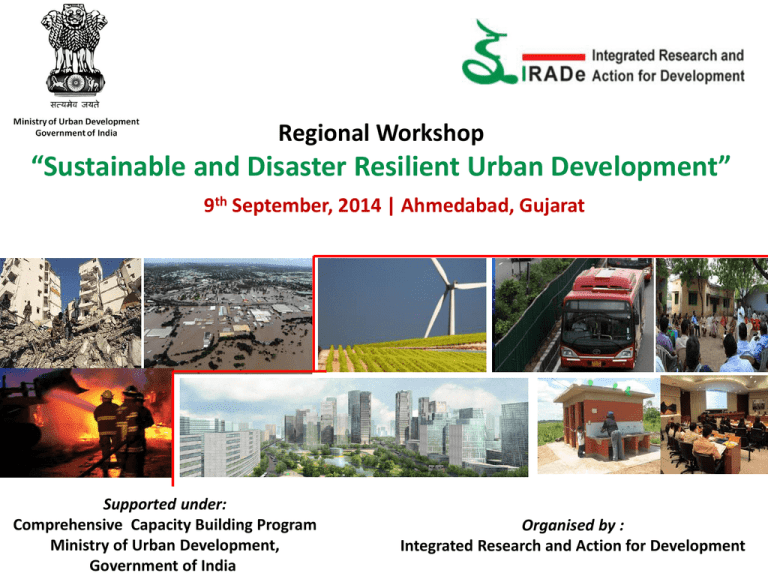
Regional Workshop
“Sustainable and Disaster Resilient Urban Development”
9th September, 2014 | Ahmedabad, Gujarat
Supported under:
Comprehensive Capacity Building Program
Ministry of Urban Development,
Government of India
Organised by :
Integrated Research and Action for Development
Energy and Power System
Urban Infrastructure and Services
Poverty Alleviation and Gender
Climate Change and Environment
Agriculture and Food Security
• Today India accounts for 17 per cent of the world’s population
• Urban population increased from 25.8 million to 377 million in
2011 residing in 900 cities and 4000 urban agglomerations.
• Haphazard and rapid urbanization results in growing vulnerability
to environmental hazards besides that.
• Increasing urban population and poverty reduces the capacity and
capability to respond to any climatic and shocks and stress
• Besides that Climate change has impacted the frequency and
intensities of the natural hazards
35
Frequency Of Disasters
30
25
Bihar
20
Gujarat
Andhra
15
Uttar Pradesh
West Bengal
10
5
0
1950-1959 1960-1969 1970-1979 1980-1989 1990-1999 2000-2009
RESILIENCE
• Resilience is defined as the capability and capacity to respond to a
disasters and ability to bounce back
• Fully functioning and sustainable cities more likely to be resilient
faster.
• Disaster Risk Reduction (DRR) & Sustainable Urban Development
strategies this involves measuring and monitoring of service delivery.
• Resource allocation: Currently, there are no specific agencies or
institutions at the city level that oversee main streaming of sustainable
and disaster resilient measures ; managing climate change knowledge;
or disseminating disaster related information to the general public.
Few recommendation to become resilient
• Prioritize a climate resilient agenda : Cities need to identify priority
activities that respond to their urgent needs for adaptation to climate
change.
• Rejuvenation of water bodies: Restoration may also help overcome the
growing water scarcity also the risk of flooding can be reduced.
• Drought and floods can be addressed simultaneously if we look after
urban lakes, ponds and wetlands.
• Expertise managing is required as green areas and parks need to be
developed for water bodies management so effluents do not accumulate
and water quality is maintained.
• Climate conscious development and spatial planning: Development
planning that incorporates climate change and variability is essential and
this should apply to institutions and governments alike.
6
Selected 20 Cities from 14 States Cites for ACCCRN Project
•Vulnerability profiles of twenty
cities from fourteen states were
prepared.
•Cities were categorized on the
basis of different ecosystem like
coastal, hills, riverine, mixed
(arid and dry) etc.
•Cities with a structured
framework
for
collecting
datasets to analyze the factors
impacting
climate
change
vulnerability.
7
HIGS Framework
A framework named HIGS was developed where “H” is Hazard Exposure; “I” stand for Infrastructure, “G” for
Governance and “S” for Socio-Economic variables.
H
S
Socio-Economic Indicators
•Demographic composition
(Sex-Ratio, age structure)
•Slum Population (Poverty
status)
•Literacy rate
•Migration flow
•Urbanisation trend and
urban sprawl
Hazards: Physical and Meteorological Indicators
•Temperature (Maximum. Minimum)
•Precipitation (Maximum. Minimum)
•Mean Sea Level
•Frequency of Drought
•Frequency of Floods
•Frequency of Cyclones
HIGS -Climate
Responsive Urban
Development
G
I
Infrastructure and Urban
Services
•Water supply
•Sewerage system
•Solid waste management
•Storm water drainage
•Transportation
•Power
•Housing
Governance- Institutions
•Participatory
•Transparency
•Accountability
•Response efficiency and capability
•Innovative financing
8
UNDP-Review of Six Cities’ Disaster Management Plans
IRADe reviewed the City Disaster Management Plan (CDMP) of 6 cities•
•
•
•
•
•
Bhubaneswar
Gangtok
Madurai
Trivandrum
Shimla
Vijayawada
•Assess the clarity, comprehensiveness, efficiency, appropriateness, and
dissemination of disaster management measures as part of city disaster
management plan
•IRADe made specific recommendations and presented strategies to each
city administration on addressing gaps established during the review
process to update the existing CDMP
MoUD-Sustainable and Disaster Resilient Urban
Development project is about……
•
Covering 10 city from different sates of India – To develop city level
information based on hazards and risks, on who is exposed and who is
vulnerable.
•
4 regional workshops: Regional workshops for finalizing strategies for
disaster resilient cities.
•
City specific capacity building and knowledge dissemination through
meeting with city stakeholders
•
Provide Information and awareness for qualitative self-assessments to
cities in terms of disaster management preparedness
•
Raising awareness among government officials on natural hazard risks
brings officials from a range of city level institutions
•
Stakeholder consultation and ownership for sensitization
•
Capacity building of local government officials and city stakeholders
including institutions, organizations etc.
SELECTED CITIES
10 Cities selected on the basis of
different ecosystems and regions
East IndiaGuwahati, Shillong, Bhubaneswar
West India- Pune, Ahmadabad,
Bhopal
South India- Vishakhapatnam,
Hyderabad
North IndiaSrinagar
Dehradun,
Thought Put forth by IRADe through this project
Process for Preparation of Report
1. City Profile
2. Natural Hazard Profile
3. Infrastructure status and Land Use
4. City Management and Governance
5. City Visits report – Observations
6. Resilience Assessment and Analysis
7. Recommendations and Concluding remarks
Case Study : Ahmedabad
Demography and Urbanisation
• 5th largest city and 7th largest urban
agglomeration of India
• Approximately 13% of the total population of
the city lives in slums in the year 2011
POPULATION IN
MILLION
DECADAL GROWTH
RATE
38%
32%
Total Population AUDA: 6,352,254,
2011 census
6.5
30%
5.2
25%
4
2.2
Decadal Growth rate (20012011):25%
Total Slum population(AMC): 7.28
lakh (2011 census)
2.9
Literacy rate: 86%2011 census)
1981
1991
2001
2011
1971
1981
1991
2001
2011
Height from mean sea level: 49 m
(MSL)(CDP, Ahmedabad)
Topography: Riverine
Exposure to Hazards
•High exposure to a
number of disasters
with
the
highest
proneness being to
earthquakes,
floods
and heat waves.
• Urban flooding
Reasons :
a) Heavy rainfall
b) Topography with
less slope
c) Poor
drainage
network
d) Chocked natural
drainage system
Slope and Topography of AMC Area
KEY FINDINGS
• The storm water drains
cover only 23% of the roads.
• The newly acquired areas of
AMC do not have storm
water
drainage
system
because of which areas get
flooded.
• The central core of the city
does not face any water
logging issues.
• Many old structures where
structural quality needs
regular assessment.
• Residential land use is
proposed to be increased in
AMC areas which can put
more pressure on land and
infrastructure services
Population Density and Locations Exposed to
Flooding in Past
Infrastructure Status in the City
Status of Service Level Benchmark in Ahmedabad City
AHMEDABAD
VARIABLES
6,352,254 (POPULATION 2011-UA)
BENCHMARK
WATER SUPPLY
Coverage of water supply
Per capita water supply
SEWERAGE SYSTEM
Coverage of waste water network services
Coverage of toilets
SOLID WASTE MANAGEMNT SYSTEM
Household coverage to collect MSW
Efficiency of collection of MSW
STROM WATER DRAINAGE
Coverage of drainage system
Incident of water logging/flooding
Low
100
135 LPCD
Medium
90%
140-160 lpcd
100
100
85%
NA
100%
100%
100%
65%
100
32%
ZERO
NA
High
Data Source: Infrastructure condition assessment is made by comparing SLB data for the cities to the present status of the infrastructure in the city. Data for
the other variable is collected from the municipal corporation and city development plan. Other sources are city disaster management authority and city
department of urban development.
Low: safe
Medium: need improvement
High: critical
Infrastructure Status in the City
Disaster Preparedness and Recovery Plan
•
•
•
•
•
•
•
Ahmedabad city awareness toward disaster resilience and capacity building is
appreciable especially after the Bhuj earthquake the state administration has taken
many steps in this context.
The Government of Gujarat for the first time in India enacted the Gujarat Disaster
Management Act, 2003.
There is a high influence of State Disaster Management Authority on the
response and recovery plan for the city. The city administration has police , fire
bridge and a control room to handle.
The city administration has implemented the building codes in the cities that are
earthquake prone.
In 2013 the state government also launched Heat Action Plan for the city
considering the impact of heat waves in the city.
Budget planning done based on past years data/actual requirements
Professional asset valuation and transparent and speedy payment systems through
ECS/RTGS to suppliers and contractors.
Vulnerability Assessment Matrix for Ahmedabad
Vulnerability Assessment Matrix for Ahmedabad
Sl. No
1
1.1
1.2
2
2.1
2.2
2.3
2.4
3
3.1
3.2
3.3
3.4
3.5
Variables
Low Medium High
Index Details and Remarks
Socio economic conditions
Population Growth
Decadal Growth 25% (2001-2011)
Percentage of slum population
13 %
Infrastructure condition ( basic services)
Water supply ( lpcd)
140-160 lpcd(FY 2012-13)
Sewerage system coverage
85%
Solid waste management system
100%
coverage
Drainage ( coverage & water
32% of storm water drain coverage
logging incidences)
Governance and Institutional Framework
State Emergency Operation Centre
Disaster response system
present
City Disaster Management
Structure in place with assigned
department
responsibilities
Dedicated persons to handle and
Not mentioned clearly. This affects
update DRR data
future prepardness
A State Disaster Management Plan is
DRR in urban planning
made
Approach top down or Bottom up
Presence of both approach brings
approach
clarity in functioning during disasters
4
4.1
4.2
4.3
4.4
4.5
4.6
4.7
4.8
Investments and Intervention to improve urban services
2% of total JnNURM funds
Investments in water sector
sanctioned for water supply
(%)
projects. Project completed
20% of total JnNURM funds
Investments in sanitation
sanctioned for 6 sewerage projects.
sector (%)
5 completed and remaining one
70% physical progress
Investments in solid waste
4% of total JnNURM funds
sector (%)
sanctioned for SWM projects.
Investments in storm water
11% of total JnNURM funds
drainage sector (%)
sanctioned for SWD projects
14% of total JnNURM funds
Investments in BSUP (%)
sanctioned for housing for poor
State Disaster Response Fund
Is there any dedicated budget
present to carry out Emergency
in place for DRR
Response & Relief activities after
any disaster.
Incentive to house owners,
business houses and public
No information found
sector who comply to DRR
Budget for low income group to
No information found
make them disaster resilient
5
Adaptation Strategies in the Cities
5.1
Human Resource-Trained workforce to
community interaction, community
awareness initiative etc
5.2
Early warning system
5.3
Updated previous disaster data base
6
Mitigation Actions by Category
6.1
Emergency Services- like Dedicated
control room for information
dispensation and coordination and
Necessary equipments in place and
functioning
6.2
Building codes for current and future
construction
There is State Disaster Response Force in
place who organizes community
interaction, community awareness initiative
etc
Present for cyclones, tsunami, not for
earthquakes
In State Disaster Management Plan
available for the whole state; city specific
not present
State Emergency Operation Centre (SEOC)
in place. Equipment's/vehicles provided by
GSDMA to Ahmedabad.
Building bylaws modified in 2007 to include
seismic parameters, rain water harvesting
and solar energy utilization
Data Source: Infrastructure condition assessment is made by comparing SLB data for the cities to the present
status of the infrastructure in the city. Data for the other variable is collected from the municipal corporation
and city development plan. Other sources are city disaster management authority and city department of
urban development.
Low: Least vulnerable, Medium: vulnerable, High: Most vulnerable
Recommendations
•
Disaster risk reduction and building resilience should be integrated into
city planning to cope with the number of hazards the city is exposed to.
•
Database management : A disaster timeline for the city with details
regarding its impact on human, animal, agriculture and infrastructure
should be maintained.
•
authorities should aim to make its citizens more resilient to impacts at the
local level.
•
A City resilience plan should be prepared for Ahmedabad considering its
exposure to hazards and potential to emerge as a major metropolitan city.
•
Rain water recharge should be made mandatory to revive depleting ground
water levels
CASE STUDY –PUNE CITY
Demography and Urbanisation
• Pune city is the second largest metropolitan
city in Maharashtra .
• It is the 8th largest metropolitan city of India.
• The growth rate in the core part of the city is
about 2 – 2.5% per year.
• The annual growth rate in peripheral wards is
about 4.4%.
• The total number of slums in Pune are 564 out
of which 353 (i.e. 64%) are notified by the
municipal body and 211 (36%) are undeclared
or un-notified (PMC).
• These areas lack basic services and amenities
that make the slum dwellers exposed to
natural hazards
•Population: 5,049,968 (2011)
•Decadal Growth rate (20012011): 30.34% compared to
population as per 2001
• Total Slum population:
6,90,545
•Literacy rate:91.61
•Sex ratio: 945 per thousand
males
•Height from mean sea level
•560 meters (MSL)
•Topography: Inland city
EXPOSURE TO HAZARDS
A ward wise disaster exposure and risk areas in Pune show that most of the wards are
exposed to hazards like earthquake, floods, landslides due to construction and fire accidents
Ward Wise Disaster Exposure and Risk Areas in Pune
Name of the Wards
Floods
Earthquake
Landslides
Fire & Industrial
Aundh
H
M
H
L
Kothrud
M
M
H
M
Ghole road
H
M
L
L
Warje – Karve Naga
H
M
M
M
Dhole Patil Road
H
L
L
L
Hadapsar
H
H
M
M
Nagar Road
L
L
L
H
Sangamwadi
L
L
L
H
BhavaniPeth
L
H
L
H
Kasba-VishramBaag
L
H
L
H
Sahakar Nagar
L
H
L
M
Tilak Road
M
H
L
M
Bibvewadi
L
H
L
L
Dhankawadi
L
M
H
L
Source: Pune City Disaster Management Plan-2012
Note: The exposure to risk is categorized in high (H), medium (M) and low (L). The darker
shades of the color represent high risk, the lighter shade represents low risk.
KEY FINDINGS
• Floods have played a critical
role in shaping Pune’s
character to a great extent
Flood Vulnerability Assessment Map
• The ongoing urbanization will
result in more run- off
• The city is also surrounded by
dams and overflowing of these
dams is the main cause of
flooding in Pune
• Low lying areas are the major
affects of floods. The
probability of floods is
moderate and intensity is low
to moderate.
• Pune has always been known for its good climate, but in the last few years the city has
been receiving heavy rainfall which has given rise to yearly floods in Pune.
Location of slums and flood zones in Pune
• There was a net increase of
around 5.33% in the built up
area
• In most of the construction
about 40 to 50 % in some
wards are weak structures
and houses are old types,
located in slums
• Around 40% of the
population lives in slums
• These slums lack basic
services
• The coverage of drains to
roads is only 52 percent
in the city
• Adequacy of the cities treatment capacity of waste water is just 71% which indicates
that 29% of wastewater is still untreated and disposed into various streams in the city
Infrastructure Status in the City
Status of Service Level Benchmark in Pune City
PUNE
5,049,968
(POPULATION 2011-UA)
VARIABLES
BENCHMARK
WATER SUPPLY
Coverage of water supply
Per capita water supply
L
100
M
H
94.2
135 LPCD
194 lpcd
100
100
97
97
100%
100%
52
100
100
55
ZERO
52
SEWERAGE SYSTEM
Coverage of waste water network services
Coverage of toilets
SOLID WASTE MANAGEMNT SYSTEM
Household coverage to collect MSW
Efficiency of collection of MSW
STROM WATER DRAINAGE
Coverage of drainage system
Incident of water logging/flooding
Data Source: Infrastructure condition assessment is made by comparing SLB data for the cities to the present status of the infrastructure in the city. Data for
the other variable is collected from the municipal corporation and city development plan. Other sources are city disaster management authority and city
department of urban development.
Low: safe
Medium: need improvement
High: critical
Disaster Preparedness and Recovery Plan
• The Government of Maharashtra (GoM) has established a mechanism for disaster
preparedness and mitigation by integrating science and technology with
communication network facilitates.
• A State Disaster Management Action Plan to support and strengthen the efforts of
the district administration.
• At the apex of the responsibility structure for response plan PMC/PCMC was given
charge managing the head of technical team for fire, city engineers and police
control room/ officers.
• The management plan for disaster is fully functioning and is one of the best
initiatives take by the municipal government at ward level
• DPR is prepared for Water supply considering the prepared covering augmentation
• ULBs have trained staff
• The revenue sources of the Corporation may be broadly classified as internal or
operating income and external receipts.
Vulnerability Assessment Matrix for Pune
Sr.No
1
1.1
Vulnerability Assessment Matrix for Pune City
Variables
Low Medium High Index Details and Remarks
Socio economic conditions
Decadal Growth 30.34% in
Population Growth
2001
1.2
Population density in the city
(Percentage of slum population)
2
2.1
Infrastructure condition ( basic services)
Water supply ( lpcd)
194 lpcd FY 2012-13
2.2
Sewerage system coverage
97%
2.3
Solid waste management system
coverage
52.7%.
2.4
Drainage ( coverage & water logging
incidences)
road drainage network is only
52 percent.
Approximately 40% of the
total population
Data Source: Infrastructure condition assessment is made by comparing SLB data for the cities
to the present status of the infrastructure in the city. Data for the other variable is collected
from the municipal corporation and city development plan. Other sources are city disaster
management authority and city department of urban development.
Low: Least vulnerable, Medium: vulnerable, High: Most vulnerable
3
Governance and Institutional Framework
3.1
Disaster response system
Fully functioning emergency
operation centre present
3.2
City Disaster Management
department
Structure in place with
assigned responsibilities
3.3
Dedicated persons to handle and
update DRR data
Done but not regular
3.4
DRR in urban planning
Mixed
3.5
Approach top down or Bottom up
approach
4
Adaptation Strategies in the Cities
4.1
Prevention( preparedness
drills/mock drills, regular training)
4.2
4.3
4.4
Human Resource-Trained workforce
to community interaction,
community awareness initiative etc
Early warning system and
rehabilitation
Updated previous disaster data base
Documented and
Implemented
reports of activity are
available
Yes through workshops/mock
drills/trainings
Present for floods
Some events are documented
in the CDMP
5
5.1
5.2
5.4
Mitigation Actions by Category
Emergency Services- like Dedicated
control room for information
dispensation and coordination and
Necessary equipment's in place and
functioning
Natural Resource Protection
Building codes for current and future
construction
Emergency operation centre is
in place
executed
Building code to include
seismic parameters, rain water
harvesting
Data Source: Infrastructure condition assessment is made by comparing SLB data for the cities to the
present status of the infrastructure in the city. Data for the other variable is collected from the municipal
corporation and city development plan. Other sources are city disaster management authority and city
department of urban development.
• The city is equipped with the technology and knowledge in the field of disaster
resilience.
• The city has detailed disaster management plan and a response system.
• E-governance and improving efficiency of delivery system of urban services is
also considered widely
Recommendations
•
Assessment of city growth and infrastructure needs to be carried out.
•
•
Detailed feasibility/engineering studies should be carried out for new projects.
Assigning of priorities within the constraint of available financial resources should be taken
care of.
•
•
The growth in population is also likely to exacerbate the already stressed modes of public
transport and will impact other services; hence, planned efforts are required to direct the
growth in the right direction.
Government should explore more options in land use planning and suitability.
•
Strict enforcement of Development Control (DC) rules must be observed.
•
The major issue in the city is the database management system for past disaster events. There
is a need to maintain and update the data for each event regularly.
•
Physical development and growth are haphazard and uncontrolled. The Development Plan
needs to be implemented correctly and reserved lands have to be used for specified purposes.
CASE STUDY BHOPAL
Demography and Urbanisation
• Population of the city increased from 1.02
lakhs in 1951 to 17.96 lakhs in 2011.
• Bhopal is a major centre of industries in
the region.
Decadal Population Growth Rate
140.00%
120.00%
117.65%
100.00%
72.97%
80.00%
74.74%
58.27%
60.00%
34.93%
40.00%
25.33%
20.00%
0.00%
1961
1971
1981
1991
2001
2011
•Total Population (Census of
India-2011):883,381 (2011)
•Population Decadal Growth:
25.33% (2001– 2011)
•Total Slum population:
4,79,699 (Census 2011)
•Literacy rate: 85.24 %
•Sex ratio:911 females per
thousand males.
•Height from mean sea level
(MSL): 427 m (MSL)
•Topography: Terrain with
several hilltops or plateaus
EXPOSURE TO HAZARDS
• Bhopal, lie in Zone II, where the maximum expected intensity is
VI (MSK).
• The city has experienced flooding of upper lake in 1973
• In 2006 City experienced 32.1 cm rains within less than 15
hours, a record in 80 years leading to loss of life and property
• The city has experienced severe water crises during 2002 &
again in 2009 due to drying up of all lakes in the city.
• The future water demand projection depending on the
population growth rates indicates that water demand in year
2031 for Bhopal city would increase to 536 MLD.
KEY FINDINGS
•
Bhopal city is exposed to the natural hazards like earthquake, floods, water
scarcity, and urban floods.
•
The presence of a large number of industries also makes the city vulnerable to
industrial disasters.
•
The infrastructure in terms of solid waste management and storm water
drainage should be improved as the current coverage is only 47% and 60%
respectively.
•
Efficient drainage system would minimize the chances of urban flooding which
the city has already experienced twice in the recent years.
•
Integrated project management covering disaster resilience, adaptation,
environment and sustainability, is highly required as the city is being upgraded
on all fronts.
Infrastructure Status in the City
Status of Service Level Benchmark in Bhopal City
VARIABLES
WATER SUPPLY
Coverage of water supply
Per capita water supply
SEWERAGE SYSTEM
Coverage of waste water network services
Coverage of toilets
SOLID WASTE MANAGEMNT SYSTEM
Household coverage to collect MSW
Efficiency of collection of MSW
STROM WATER DRAINAGE
Coverage of drainage system
Incident of water logging/flooding
BENCHMARK
L
BHOPAL
1,883,381
(POPULATION 2011-UA)
M
100
135 LPCD
58%
150 lpcd
100
100
12%
81%
100%
100%
47%
81%
100
ZERO
60%
0%
H
Data Source: Infrastructure condition assessment is made by comparing SLB data for the cities to the present status of the infrastructure in the
city. Data for the other variable is collected from the municipal corporation and city development plan. Other sources are city disaster
management authority and city department of urban development.
Low: safe
Medium: need improvement
High: critical
Disaster Preparedness and Recovery Plan
•
•
An institutional mechanism needs to be developed which brings all agencies on
a common platform such that overlaps, departmental delays, duplication is
reduced and faster delivery of projects is ensured
The city lack any formal implementation of the disaster management plan.
•
It is found that SDMA has not developed City disaster management plan nor
disaster preparedness manuals for schools, apartments, govt. offices, Hospitals
and commercial buildings.
•
Recovery of expenditure rendered to public through tax and bills are on lower
side and needs transparent and efficient mechanisms.
•
The State Disaster Management Authority (SDMA) policy statement there is
discussion of dedicated funds for the disaster management activity but
whether the funds are made available and utilized in capacity building and
awareness exercises is not mentioned.
Vulnerability Assessment Matrix for Bhopal
Vulnerability Assessment Matrix for Bhopal City
Sl.No
Variables
Low
Medium
High
Index Details and Remarks
1
Socio economic conditions
1.1 Decadal growth % of population
As per census 2011 the decadal growth % is
25.33%
1.2 Population density in the city
Slum population is approximately 26%
(hazard prone areas/slum
population percentage)
1.3 Percentage of urban poor
As per census 2001 BPL population of the
population (BPL)
city above 50%
2
Infrastructure condition ( basic services)
2.1 Water supply ( lpcd)
Per capita water supply is 150 lpcd
2.2 Sewerage system coverage
Sewerage system coverage 81%
2.3 Solid waste management system
47% of the households were covered under
coverage
solid waste management system
2.4 Drainage ( coverage & water
Drainage coverage in the city was 60%, no
logging incidences)
water logging incidences occurred
Data Source: Infrastructure condition assessment is made by comparing SLB data for the cities to the
present status of the infrastructure in the city. Data for the other variable is collected from the municipal
corporation and city development plan. Other sources are city disaster management authority and city
department of urban development.
Low: Least vulnerable, Medium: Vulnerable, High: Most vulnerable
S.No
Variables
Low Medium High
3
Governance and Institutional Framework
3.1
3.4
3.5
Disaster response system (Emergency
Operation Centre present physically)
City Disaster Management department
Dedicated persons to handle and update DRR
data
DRR in urban planning
Approach top down or Bottom up approach
4
Investments and Intervention to improve urban services
4.1
Investments in water sector (%) of allocated
budget spent
Investments in sanitation sector (%)of
allocated budget spent
Investments in solid waste sector (%)of
allocated budget spent
Is there any dedicated budget in place for
DRR
Incentive to house owners, business houses
and public sector who comply to DRR
Budget for low income group to make them
disaster resilient
3.2
3.3
4.2
4.3
4.6
4.7
4.8
Index Details and Remarks
Emergency Operation Centre not present
physically
Not present
No information found
Not done
District Disaster Management plan doesn’t
exist only a document for industrial
disaster management plan is there.
Rs 43137.94 lakhs allocated , 39% financial
progress
No investments
No investments
No information found
No information found
No information found
S.No
Variables
5
Adaptation strategies in the cities
5.1
5.3
5.4
Prevention( preparedness drills/mock drills,
regular training)
Human Resource-Trained workforce to
community interaction, community awareness
initiative etc
Early warning system and rehabilitation
Updated previous disaster data base
6
Mitigation Actions by Category
6.1
Emergency Services- like Dedicated control
room for information dispensation and
coordination and Necessary equipment's in
place and functioning
Natural Resource Protection
5.2
6.2
6.3
Building codes for current and future
construction
Low
Medium
High
Index Details and Remarks
No information found
No information found
No information found
No consolidated data base in found
with loss figuresaffecting the future
preparedness
No information found
Rs 4000 lakhs allocated for
environmental up gradation (CDP),
100 % financial progress
Not revised
Data Source: Infrastructure condition assessment is made by comparing SLB data for the cities to the present
status of the infrastructure in the city. Data for the other variable is collected from the municipal corporation
and city development plan. Other sources are city disaster management authority and city department of
urban development.
Low: Least vulnerable, Medium: Vulnerable, High: Most vulnerable
Recommendations
•
•
•
•
•
•
•
For a better governance and optimum available resource utilization is necessary.
It is recommended that local government should put an effort to formulate the
City Disaster Management Plan apart from the Industrial Disaster Management
plan .
Data should be updated at regular interval i.e. yearly) at one place so that it can be
easily accessed by all the government agencies.
The natural resource component shall also not be ignored in the revised city
development plan and adequate budget shall be assigned for it.
A trained workforce for post disaster relief, community interaction, & awareness is
recommended.
The capacity building exercises like preparedness drills must be conducted on
regular basis.
The catchment areas in the cities should also be managed efficiently to minimize
the risk of flooding.
A Comparative Overview
A Comparative Vulnerability Matrix of Cities
Exposure to Hazards of the Cities
Sl. No
1.1
1.2
1.3
1.4
1.5
1.6
1.7
2.1
2.2
2.3
2.4
2.5
2.6
3.1
3.2
3.3
3.4
3.5
3.6
Variables
Low
Medium High
Index Details and Remarks
Vulnerability Assessment Matrix for Ahmedabad City
Seismic Zone III
Earthquakes
Landslides
No records
Urban Floods
Incidence of urban floods every two to three years.
According to the wind and cyclone zoning United
Cyclones
Nations Development Programme (UNDP) report
Ahmedabad lies in the "very high damage risk".
Water scarcity (days/occurrences)
Incidence of water scarcity in 1999-2000
0
Heat Waves (Temp crossing 40 C and
Existing records indicate that average summer
number of occurrences)
temperatures increasing,
Industrial Hazards/Fire
High concentration of MAH units in Ahmedabad
Vulnerability Assessment Matrix for Pune City
Seismic Zone III
Earthquakes
Landslides
Only in the out city areas
Urban Floods
Yearly occurrence and high frequency
Water scarcity (days/occurrences)
Yearly occurrence and in winter months
0
Heat Waves (Temp crossing 40 C and
Gradually intensity is increasing
number of occurrences)
Industrial Hazards/Fire
Rarely occurs low frequency
Vulnerability Assessment Matrix for Bhopal City
Earthquakes
Bhopal lies in Zone II
Landslides
City not prone to landslides
Urban Floods
Flooding occurred in 1973-74 and 2006 due to heavy
rains
Cyclones
City not prone to cyclones
0
Heat Waves (Temp crossing 40 C and
City vulnerable to heat waves.
number of occurrences)
Water Scarcity(days/occurrences)
Severe water crisis in 2002 and 2009
Comparative Resilience Matrix : Efficiency of Basic Infrastructure and Services
INFRASTRCUTURE AND SERVICES
AHMEDABAD
VARIABLES
BENCHMARK
WATER SUPPLY
Coverage of water supply
Per capita water supply
SEWERAGE SYSTEM
Coverage of waste water network services
Coverage of toilets
SOLID WASTE MANAGEMNT SYSTEM
Household coverage to collect MSW
Efficiency of collection of MSW
STROM WATER DRAINAGE
Coverage of drainage system
Incident of water logging/flooding
100
L
PUNE
BHOPAL
(POPULATION 2011-UA)
6,352,254 5,049,968
1,883,381
M
90%
H
L M H
L M H
94.2%
135 LPCD 140-160 lpcd 194 lpcd
L
M H
58%
150 lpcd
100
100
85%
NA
97
97
12%
81%
100%
100%
100%
65%
52
100
47%
81%
100
32%
55
60%
ZERO
NA
52
0%
Data Source: Infrastructure condition assessment is made by comparing SLB data for the cities to the present status of the infrastructure in the
city. Data for the other variable is collected from the municipal corporation and city development plan. Other sources are city disaster
management authority and city department of urban development.
Low: safe
Medium: need improvement
High: critical
Recommendations and Priorities for Action and Strategies
Response &Recovery : Improvement on disaster response system and building strategies
for improving recovery system.
Infrastructure Conditions: Infrastructure towards sewerage, solid waste management and
drainage must be developed to improve the quality of basic services provided to urban poor.
Government and Institutional Framework: Under government and institutional framework,
responsibility should be assigned to update the disaster data with loss figures (impact).
There is an urgent need to integrate urban planning to DRR.
Investment and Interventions: From the investment data it has been found that funds are
not invested towards BSUP, MSW and sanitation, despite budgetary provisions being made
for the same.
Adaptation Strategies: Towards adaptation strategies to build administration for proactive
preparedness and trained staff
Interventions are required in early warning system (floods and cyclones) and disaster
database update for future reference.
Mitigation Actions: prepared for emergency services and revision of building codes.
interventions for the protection of natural resources.
Climate Resilience Plan Development of State / Regional
Vulnerability assessment
of cities at the city level
Strengthen strategic Role
of ULBs to bring more
investment
Incorporation of prudent
climate and disaster
resilient plan into City
Development Plan &
Master Plan
Mainstreaming of climate
concerns in many other
related initiatives
THANK YOU
Dr. Jyoti K. Parikh
jyotiparikh@irade.org
C 80 Shivalik, Malviya Nagar,
New Delhi 110017,
Tel: +91 (11) 2668 2226
Fax:2667 6180,
Web: www.irade.org
49


